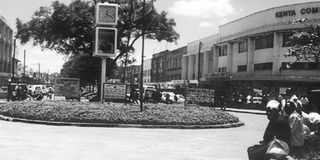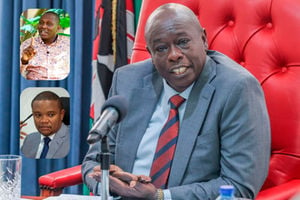How Thika identity crisis ended up in Parliament

Thika town started as a small resting place for Kikuyu and Kamba traders. White farmers then made it a train stop for their agricultural produce. PHOTO/FILE
What you need to know:
- The first known trader to start a shop in Thika was a man named Jamal Hirji Ojami.
- Being at the border of Kiambu and Murang’a, Thika faced an identity crisis.
- The Boundary Commission also created a district called Thika, which had one leg in Kiambu and the other in Murang’a.
The modern-day Thika town started as a small African village that was used as a resting place by Kikuyu and Kamba traders.
By 1910, white settler farmers were using it as a train stop for their agricultural produce.
Three years later, the town had started to emerge as a convenient stopover for European big game hunters.
The first known trader to start a shop in Thika was a man named Jamal Hirji Ojami. He opened a store in 1914 on the site presently occupied by the Blue Post Hotel on the north bank of Chania River.
It was only after the Second World War that the town grew out of its bush settlement state, immortalised in the bestselling novel, The Flame Trees of Thika by Mrs Elspeth Huxley.
All this time, Thika was part of Nairobi County Council.
It was not until 1953 that the town managed to sever its connections with Nairobi and formed its own urban district council. By then, five factories had been established and schools built. The town also had its own hospital.
IDENTITY CRISIS
Being at the border of Kiambu and Murang’a, Thika faced an identity crisis.
When the county council system was introduced, the old Thika ceased to exist and the councillors north of Chania River were absorbed into the new Murang’a County Council.
Those in the south were absorbed into Kiambu County Council. But there remained something called Thika District.
In 1966, Bildad Kaggia introduced a motion in Parliament that sought to end the confusion over Thika District.
The Kaggia Motion read: “That in view of the present confusion and overlapping of authority between the Murang’a County Council and Thika Administration in the former Thika District, which is now part and parcel of the Murang’a County, this House urges the government to remove the confusion by extending the Murang’a district commissioner’s jurisdiction to the whole of Murang’a County area and to restrict the jurisdiction of Thika district commissioner to Thika municipality, and to introduce such legislation for amendment of the Constitution as may be necessary for that purpose.”
BOUNDARY ANOMALIES
The Boundary Commission had created the boundary between Murang’a and Kiambu counties on River Chania.
It meant that the south of the river was in Kiambu County and the north was in Muranga County.
The Boundary Commission also created a district called Thika, which had one leg in Kiambu and the other in Murang’a.
This meant that part of the then Kiharu Constituency was administered under Thika District while part of Gatundu was in the Thika Administrative District.
While the Kiambu and Murang’a county councils had asked the government to remove these anomalies, nothing had been done.
During the colonial times, a section known as Thika District had been carved out to include the European big farms extending to parts of Machakos, Murang’a, and Kiambu.
The confusion had been created by the colonial government, which had been determined to see that the area occupied by White settlers was administered separately.
AFTER INDEPENDENCE
“We were tolerating this state of affairs during the colonial times, but we cannot expect it to continue after independence,” complained Kaggia.
He argued in parliament that it made no sense that “just a small ‘European’ area should be made a district by itself”.
When the minister of State, James Nyamweya, spoke, he admitted that there were administrative problems.
However, he proposed to change the motion to read: “That in view of the present overlapping between Murang’a County Council and Thika Administration in the former Thika District, which is now part and parcel of the Murang’a County, this House urges the government to remove the overlapping jurisdiction between the Murang’a County Council and Thika District Administration and to introduce such legislation as may be necessary for that purpose.”
The motion was passed in February 1966 and Thika District ceased to exist. The jurisdiction was taken over by both the Kiambu and Murang’a district commissioners.




